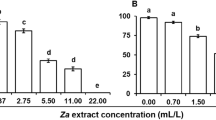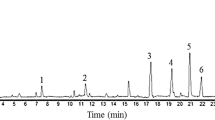Abstract
To prevent the loss of grains in stored products due to pests, an alternative pest control technique to insecticide spraying is required. The use of natural materials for this purpose can be beneficial, and in this context, we screened 21 plants and found that an Iteaceae plant inhibited the growth of lepidopteran insect larvae. Accordingly, following purification and analysis of the plant extract from I. virginica leaves, allitol and d-allulose (psicose) were identified as growth inhibitors against larvae of the Mediterranean flour moth, Ephestia kuehniella Zeller (Lepidoptera: Pyralidae). The contents of allitol and d-allulose in I. virginica leaves were estimated to be 14.4 and 4.17 mg/g fr. wt, respectively, and their half-maximal effective concentration (EC50) values were 15.7 and 30.3 mg/g diet, respectively. Therefore, the growth inhibition activity in I. virginica leaves was mainly attributed to the presence of allitol. However, both compounds may be used in insecticidal reagents, and in particular, since the safety of d-allulose has already been confirmed, it could allow this pest management reagent to be directly mixed with stored-product foods.

Similar content being viewed by others
References
Ayers BJ, Hollinshead J, Saville AW, Nakagawa S, Adachi I, Kato A, Izumori K, Bartholomew B, Fleet GWJ, Nash RJ (2014) Iteamine, the first alkaloid isolated from Itea virginica L. inflorescence. Phytochemistry 100:126–131
Bohm AB, Chalmers G, Bhat UG (1988) Flavonoids and the relationship of Itea to the Saxifragaceae. Phytochemistry 27:2651–2653
Castañé C, Riudavets J, Lucas E (2018) Parasitism of single or combined pyralid populations by Venturia canescens and Habrobracon hebetor in laboratory and storeroom conditions. J Pest Sci 91:1421–1428
Fisher ML, Fowler FE, Denning SS, Watson DW (2017) Survival of the house fly (Diptera: Muscidae) on truvia and other sweeteners. J Med Entomol 54:999–1005
Fowler SPG (2016) Low-calorie sweetener use and energy balance: results from experimental studies in animals, and large-scale prospective studies in humans. Physiol Behav 164:517–523
Hagstrum DW, Subramanyam B (2006) Fundamentals of stored-product entomology. American Associate of Cereal Chemists International, St. Paul
Hassanin HAM, Mu W, Koko MYF, Zhang T, Masamba K, Jiang B (2017) Allitol: production, properties and applications. Int J Food Sci Tech 52:91–97
Hayashi N, Iida T, Yamada T, Okuma K, Takehara I, Yamamoto T, Yamada K, Tokuda M (2010) Study on the postprandial blood glucose suppression effect of d-psicose in borderline diabetes and the safety of long-term ingestion by normal human subjects. Biosci Biotechnol Biochem 74:510–519
Hough L, Stacey BE (1963) The occurrence of d-ribohexulose in Itea ilicifolia, Itea virginica, and Itea yunnanensis. Phytochemistry 2:315–320
Hough L, Stacey BE (1966) Variation in the allitol content of Itea plants during photosynthesis. Phytochemistry 5:3171–3175
Iwasaki Y, Sendo M, Dezaki K, Hira T, Sato T, Nakata M, Goswami C, Aoki R, Arai T, Kumari P, Hayakawa M, Masuda C, Okada T, Hara H, Drucker DJ, Yamada Y, Tokuda M, Yada T (2018) GLP-1 release and vagal afferent activation mediate the beneficial metabolic and chronotherapeutic effects of d-allulose. Nat Commun 9:113
Jacob TA, Cox PD (1977) The influence of temperature and humidity on the life-cycle of Ephestia kuehniella Zeller (Lepidoptera: Pyralidae). J Stored Prod Res 13:107–118
Kanda Y (2013) Investigation of the freely available easy-to-use software ‘EZR’ for medical statistics. Bone Marrow Transpl 48(3):452–458
Kato N, Takahashi M, Shibayama M, Munakata K (1972) Antifeeding active substances for insects in Clerodendron tricotomum Thunb. Agr Biol Chem 36:2579–2582
Kato-Noguchi H, Takaoka T, Izumori K (2005) Psicose inhibits lettuce root growth via a hexokinase-independent pathway. Physiol Plant 125:293–298
Kato-Noguchi H, Takaoka T, Okada K (2011) Effect of the d-glucose analog, d-allose, on the growth of Arabidopsis roots. Weed Biol Manag 11:7–11
Kavallieratos NG, Athanassiou CG, Saitanis CJ, Kontodimas DC, Roussos AN, Tsoutsa MS, Anastassopoulou UA (2007) Effect of two azadirachtin formulations against adults of Sitophilus oryzae and Tribolium confusum on different grain commodities. J Food Prot 70:1627–1632
Kłyś M, Malejky N, Nowak-Chmura M (2017) The repellent effect of plants and their active substances against the beetle storage pests. J Stored Prod Res 74:66–77
Larson Z, Subramanyam B, Zurek L, Hermann T (2008) Diversity and antibiotic resistance of enterococci associated with stored-product insects collected from feed mills. J Stored Prod Res 44:198–203
Liu ZL, Chu SS, Jiang GH (2009) Feeding deterrents from Zanthoxylum schinifolium against two stored-product insects. J Agric Food Chem 57:10130–10133
Lozowicka B, Kaczyński P (2013) Synthesis and antifeedant activity of novel alpha-asarone derivatives against stored-product pests. Pest Manag Sci 69:964–974
Matsui K, Wada K, Munakata K (1976) Insect antifeeding substances in Parabenzoin praecox and Piper futokadzura. Agric Biol Chem 40:1045–1046
Matsuo T, Izumori K (2009) D-Psicose inhibits intestinal α-glucosidase and suppresses the glycemic response after ingestion of carbohydrates in rats. J Clin Biochem Nutr 45:202–206
Mizobuchi K, Nishihara H (2009) Effect of rare sugars on physiology of yeast. Mem Fac Edu, Kagawa Univ, Part II 59:11–19
Mondal KAMSH, Parween S (2000) Insect growth regulators and their potential in the management of stored-product insect pests. Integ Pest Manag Rev 5:255–295
Nakakita H (1990) Hormonal control of inhibition of pupation caused by crowding larvae of Tribolium freemani Hinton (Coleoptera: Tenebrionidae). Appl Entomol Zool 25:347–353
Nishii N, Nomizo T, Takashima S, Matsubara T, Tokuda M, Kitagawa H (2016) Single oral dose safety of d-allulose in dogs. J Vet Med Sci 78:1079–1083
Ochiai M, Nakanishi Y, Yamada T, Iida T, Matsuo T (2013) Inhibition by dietary d-psicose of body fat accumulation in adult rats3 fed a high-sucrose diet. Biosci Biotechnol Biochem 77:1123–1126
Oosaka K (2009) Possibility as monosaccharide laxative of rare sugar alcohols. Yakugaku Zasshi 129:575–580
Oshima H, Kimura I, Izumori K (2006) Psicose contents in various food products and its origin. Food Sci Technol Res 12:137–143
Park C, Kim SI, Ahn YJ (2003) Insecticidal activity of asarones identified in Acorus gramineus rhizome against three coleopteran stored-product insects. J Stored Prod Res 39:333–342
Pascual N, Marco MP, Bellés X (1990) Azadirachtin induced imaginal moult deficiencies in Tenebrio molitor L. (Coleoptera: Tenebrionidae). J Stored Prod Res 26:53–57
Phillips TW, Throne JE (2010) Biorational approaches to managing stored-product insects. Annu Rev Entomol 55:375–397
Popławski J, Łozowick B, Dubis AT, Lachowska B, Winiecki Z, Nawrot J (2000) Feeding-deterrent activity of α-asarone isomers against some stored Coleoptera. Pest Manag Sci 56:560–564
Popp J, Pető K, Nagy J (2013) Pesticide productivity and food security. A review Agron Sustain Dev 33:243–255
R Core Team (2018) R: a language and environment for statistical computing. R Foundation for Statistical Computing, Vienna, Austria. URL https://www.R-project.org/
Rahim M (1998) Biological activity of azadirachtin-enriched neem kernel extracts against Rhyzopertha dominica (F.) (Coleoptera: Bostrichidae) in stored wheat. J Stored Prod Res 34:123–128
Rajendran S, Parveen HKM (2005) Insect infestation in stored animal products. J Stored Prod Res 41:1–30
Sato M, Kurose H, Yamasaki T, Izumori K (2008) Potential anthelmintic: d-psicose inhibits motility, growth and reproductive maturity of L1 larvae of Caenorhabditis elegans. J Nat Med 62:244–246
Schmutterer H, Baumgart M, Freisewinkel D, Langenwald J, Nicol CMY (1993) The effects of neem oil and other neem products on nymphs and resulting adults of Schistocerca gregaria, Nomadacris septemfasciata, Locusta migratoria migratorioides, and Zonocercus variegatus. J Appl Entomol 116:178–186
Shintani T, Sakoguchi H, Yoshihara A, Izumori K, Sato M (2017) d-Allulose, a stereoisomer of d-fructose, extends Caenorhabditis elegans lifespan through a dietary restriction mechanism: a new candidate dietary restriction mimetic. Biochem Biophys Res Commun 493:1528–1533
Shukla R, Singh P, Prakash B, Dubey NK (2016) Assessment of essential oil of Acorus calamus L. and its major constituent β-asarone in post-harvest management of Callosobruchus chinensis L. J Essent Oil Bear Pl 19:542–552
Stejskal V, Stara J, Pekar S, Nesvorna M, Hubert J (2020) Sensitivity of polyphagous (Plodia interpunctella) and stenophagous (Ephestia kuehniella) storage moths to residual insecticides effect of formulation and larval age. Insect Sci (in press)
Takeshita K, Ishida Y, Takada G, Izumori K (2000) Direct production of allitol from d-fructose by a coupling reaction using d-tagatose 3-epimerase, ribitol dehydrogenase and formate dehydrogenase. J Biosci Bioeng 90:545–548
Walia S, Saha S, Tripathi V, Sharma KK (2017) Phytochemical biopesticides: some recent developments. Phytochem Rev 16:989–1007
Wölnerhanssen BK, Cajacob L, Keller N, Doody A, Rehfeld JF, Drewe J, Peterli R, Beglinger C, Meyer-Gerspach AC (2016) Gut hormone secretion, gastric emptying, and glycemic responses to erythritol and xylitol in lean and obese subjects. Am J Physiol Endocrinol Metab 310:1053–1061
Yaman M, Acar KF, Radex R (2015) A Nucleopolyhedrovirus from the Mediterranean flour moth, Ephestia kuehniella (Lepidoptera: Pyralidae). Appl Entomol Zool 50:355–359
Zanno PR, Miura I, Nakanishi K, Elder DL (1975) Structure of the insect phagorepellent azadirachtin. Application of PRFT/CWD carbon-13 nuclear magnetic resonance. J Am Chem Soc 97:1975–1977
Acknowledgements
The authors would like to thank the Japan Science and Technology Agency (JST) (grant Nos; AS221Z03387E and AS242Z03382N) for their financial support. We would like to thank Editage (www.editage.com) for English language editing.
Funding
This research was supported in part by the Adaptable and Seamless Technology Transfer Program through Target-driven R&D (A-STEP; AS221Z03387E and AS242Z03382N) from the Japan Science and Technology Agency (JST).
Author information
Authors and Affiliations
Corresponding author
Ethics declarations
Conflict of interest
No potential conflict of interest was reported by the authors.
Additional information
Publisher's Note
Springer Nature remains neutral with regard to jurisdictional claims in published maps and institutional affiliations.
Rights and permissions
About this article
Cite this article
Tebayashi, S., Onishi, S., Seo, K. et al. Identification of allitol and d-allulose from Itea virginica as insect growth inhibitors for the control of Mediterranean flour moth, Ephestia kuehniella (Lepidoptera: Pyralidae). Appl Entomol Zool 56, 357–364 (2021). https://doi.org/10.1007/s13355-021-00741-x
Received:
Accepted:
Published:
Issue Date:
DOI: https://doi.org/10.1007/s13355-021-00741-x




